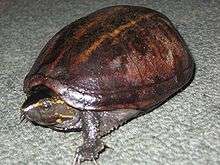Striped mud turtle
| Striped mud turtle | |
|---|---|
 | |
| Kinosternon baurii | |
| Scientific classification | |
| Kingdom: | Animalia |
| Phylum: | Chordata |
| Subphylum: | Vertebrata |
| Class: | Reptilia |
| Order: | Testudines |
| Family: | Kinosternidae |
| Genus: | Kinosternon |
| Species: | K. baurii |
| Binomial name | |
| Kinosternon baurii[1] (Garman, 1891)[1] | |
| Synonyms[2] | |
| |
The striped mud turtle (Kinosternon baurii) is a species of turtle endemic to the United States.
Etymology
The specific name, baurii, is in honor of herpetologist Georg Baur.[3]
Geographic range
Striped mud turtles are found in Florida, Georgia, North Carolina, South Carolina and Virginia.[1]
Description
They have three light-colored stripes along the length of the smooth carapace. They can grow to 8–12 cm (3-4¾ inches) carapace length.
Habitat and behavior
Kinosternon baurii is a common species found in freshwater habitats. They wander about on land more than any other mud turtle and can sometimes be observed foraging for food in cow dung.
Diet
Striped mud turtles are omnivorous. They eat insects, snails, fish, carrion, algae, and plants.
Captivity
As pets they are easy to care for, readily eating commercial turtle foods, feeder fish, and worms.
Reproduction
They nest from September to June. The eggs, which are slightly over 2.5 cm (1 in) long, hatch 13 to 19 weeks later. The hatchlings are about the 2.5 cm in size and, unlike the adult turtles, have keeled carapaces.
References
- 1 2 3 4 Rhodin 2010, p. 000.96
- ↑ Fritz Uwe; Peter Havaš (2007). "Checklist of Chelonians of the World". Vertebrate Zoology. 57 (2): 251. ISSN 1864-5755. Archived from the original (PDF) on 2010-12-17. Retrieved 29 May 2012.
- ↑ The Reptile Database. www.reptile-database.org.
- Reptile Database
- National Audubon Society Field Guide to Reptiles and Amphibians, Alfred A. Knopf, (c)2000 Chanticleer Press, Inc., page 438-9.
- Bibliography
- Rhodin, Anders G.J.; van Dijk, Peter Paul; Inverson, John B.; Shaffer, H. Bradley (2010-12-14). "Turtles of the world, 2010 update: Annotated checklist of taxonomy, synonymy, distribution and conservation status". Chelonian Research Monographs. 5. Archived from the original (PDF) on 2010-12-15.
